University Accounting Principles Assignment - Semester 1
VerifiedAdded on 2021/04/24
|20
|1397
|43
Homework Assignment
AI Summary
This accounting assignment solution addresses key concepts in financial accounting. It begins by differentiating between economic and non-economic decisions, illustrated with examples from various business scenarios, including production management, non-profit organizations, and small businesses. The solution then provides a detailed analysis of financial statements, including journal entries, income statements, statements of changes in owner’s equity, and balance sheets, along with recommendations for business performance improvement. The assignment also explores the legal and operational differences between sole traders and distinct business entities. Furthermore, it covers trial balance adjustments and potential accounting errors. Finally, the assignment delves into corporate social responsibility and ethical issues, particularly the debate surrounding health warnings on cigarette packs, providing a nuanced perspective on stakeholder interests and ethical decision-making.
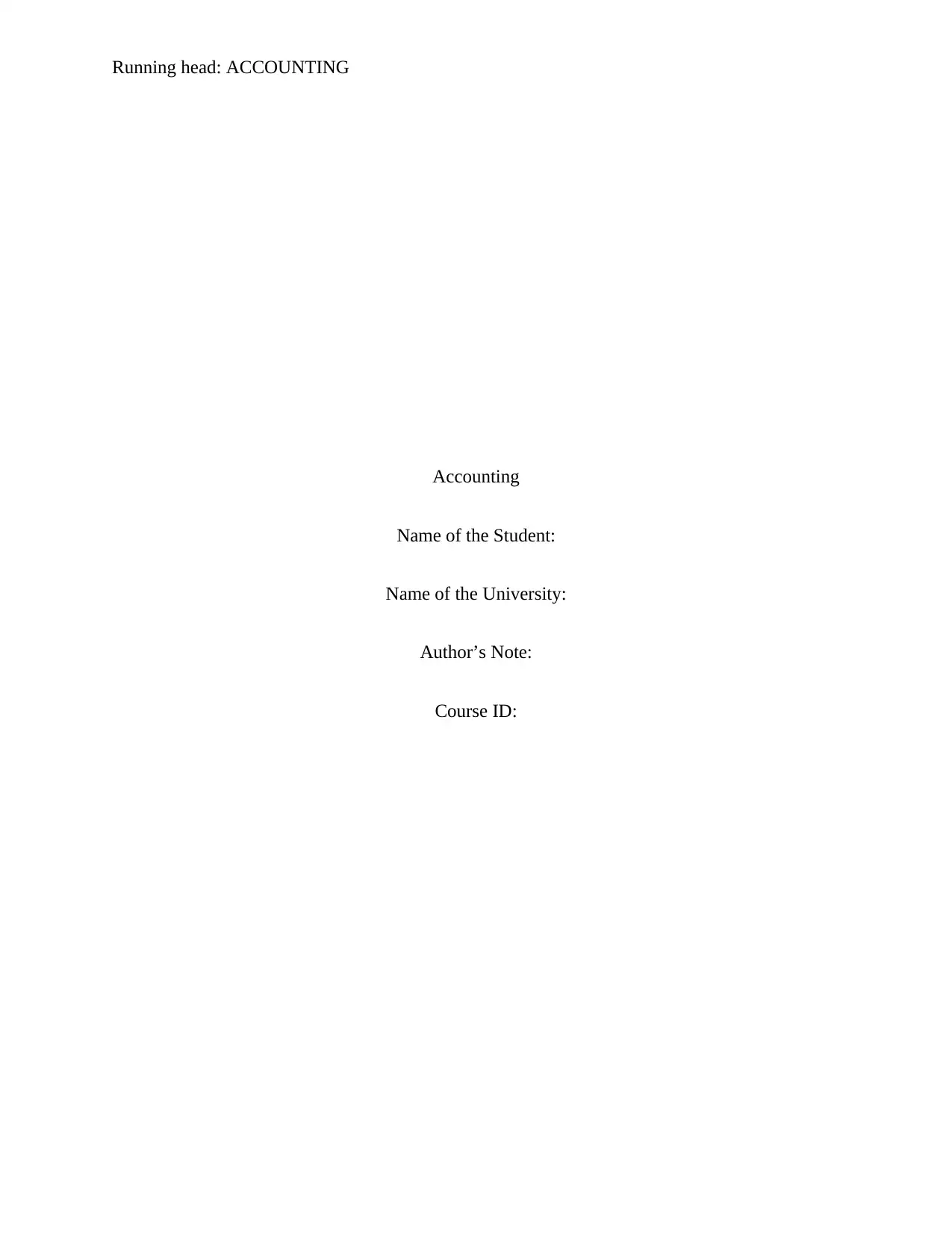
Running head: ACCOUNTING
Accounting
Name of the Student:
Name of the University:
Author’s Note:
Course ID:
Accounting
Name of the Student:
Name of the University:
Author’s Note:
Course ID:
Paraphrase This Document
Need a fresh take? Get an instant paraphrase of this document with our AI Paraphraser
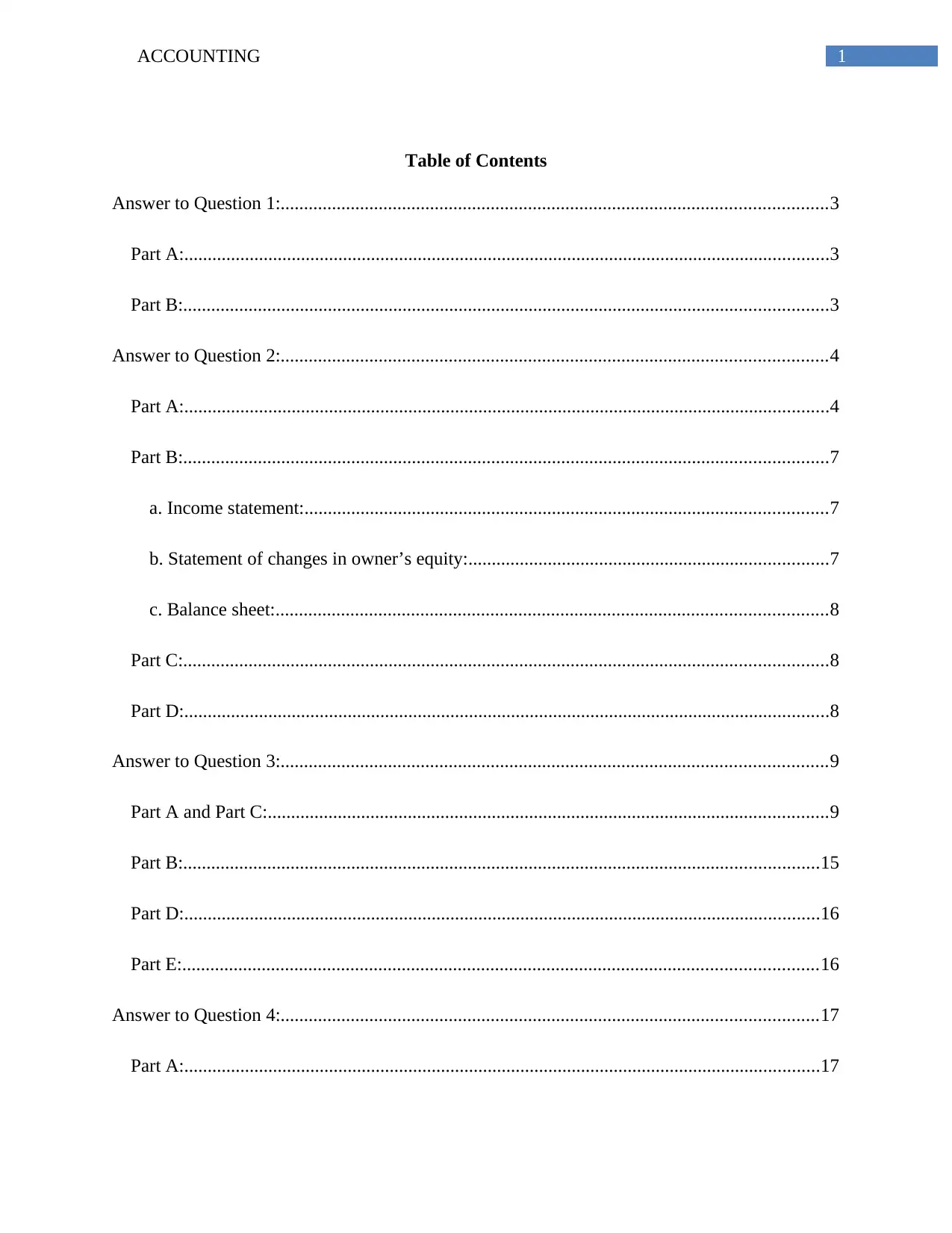
1ACCOUNTING
Table of Contents
Answer to Question 1:.....................................................................................................................3
Part A:..........................................................................................................................................3
Part B:..........................................................................................................................................3
Answer to Question 2:.....................................................................................................................4
Part A:..........................................................................................................................................4
Part B:..........................................................................................................................................7
a. Income statement:................................................................................................................7
b. Statement of changes in owner’s equity:.............................................................................7
c. Balance sheet:......................................................................................................................8
Part C:..........................................................................................................................................8
Part D:..........................................................................................................................................8
Answer to Question 3:.....................................................................................................................9
Part A and Part C:........................................................................................................................9
Part B:........................................................................................................................................15
Part D:........................................................................................................................................16
Part E:........................................................................................................................................16
Answer to Question 4:...................................................................................................................17
Part A:........................................................................................................................................17
Table of Contents
Answer to Question 1:.....................................................................................................................3
Part A:..........................................................................................................................................3
Part B:..........................................................................................................................................3
Answer to Question 2:.....................................................................................................................4
Part A:..........................................................................................................................................4
Part B:..........................................................................................................................................7
a. Income statement:................................................................................................................7
b. Statement of changes in owner’s equity:.............................................................................7
c. Balance sheet:......................................................................................................................8
Part C:..........................................................................................................................................8
Part D:..........................................................................................................................................8
Answer to Question 3:.....................................................................................................................9
Part A and Part C:........................................................................................................................9
Part B:........................................................................................................................................15
Part D:........................................................................................................................................16
Part E:........................................................................................................................................16
Answer to Question 4:...................................................................................................................17
Part A:........................................................................................................................................17
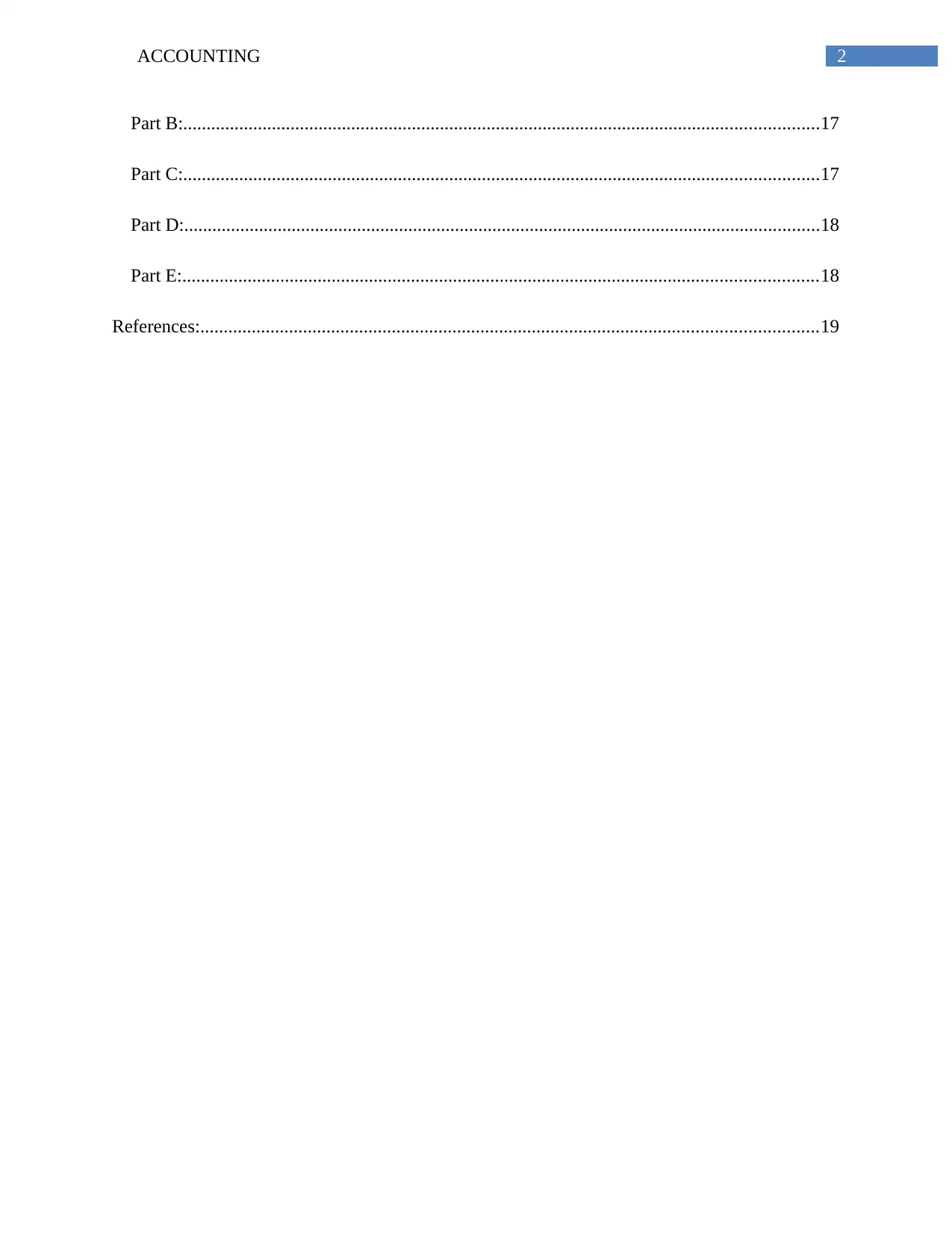
2ACCOUNTING
Part B:........................................................................................................................................17
Part C:........................................................................................................................................17
Part D:........................................................................................................................................18
Part E:........................................................................................................................................18
References:....................................................................................................................................19
Part B:........................................................................................................................................17
Part C:........................................................................................................................................17
Part D:........................................................................................................................................18
Part E:........................................................................................................................................18
References:....................................................................................................................................19
⊘ This is a preview!⊘
Do you want full access?
Subscribe today to unlock all pages.

Trusted by 1+ million students worldwide
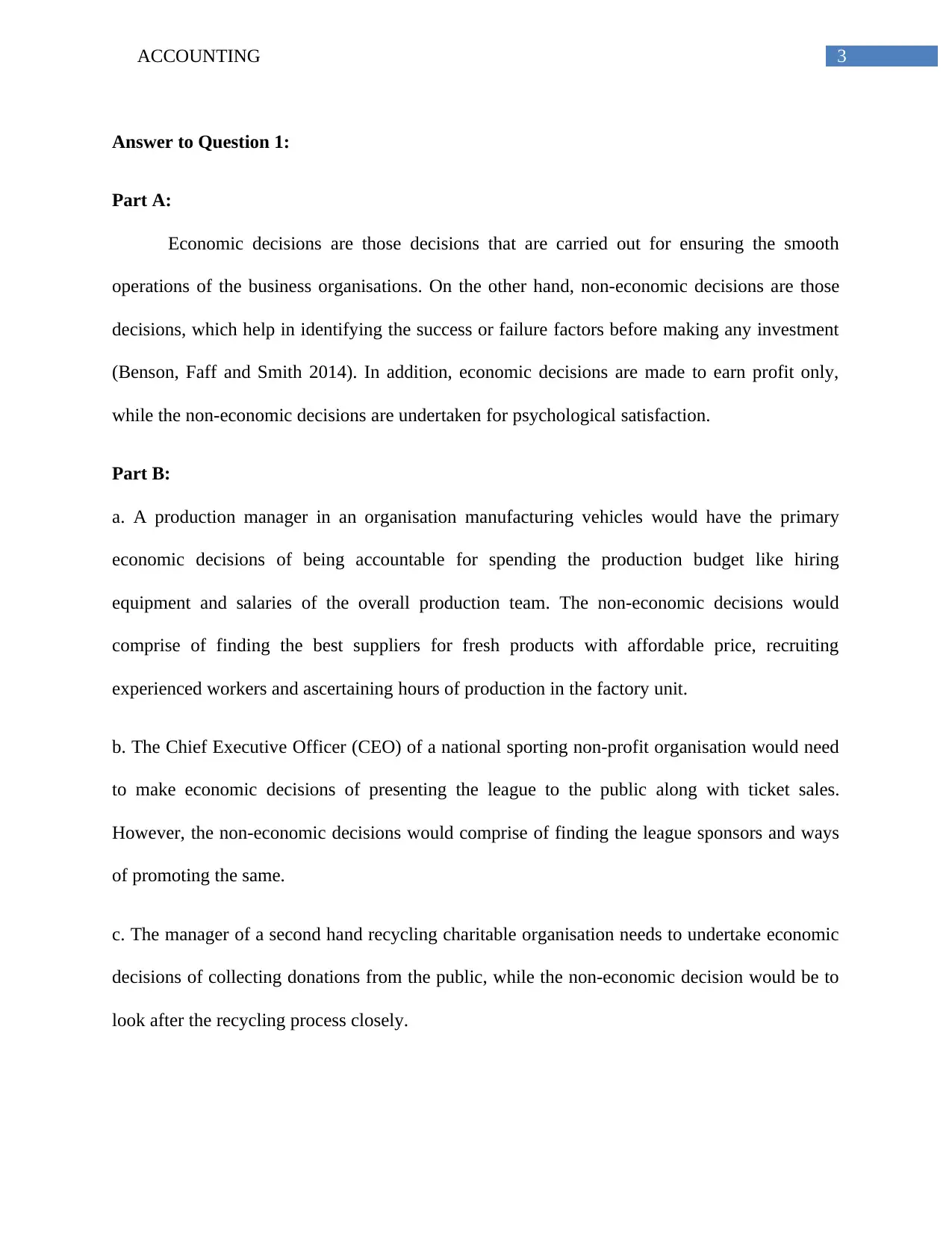
3ACCOUNTING
Answer to Question 1:
Part A:
Economic decisions are those decisions that are carried out for ensuring the smooth
operations of the business organisations. On the other hand, non-economic decisions are those
decisions, which help in identifying the success or failure factors before making any investment
(Benson, Faff and Smith 2014). In addition, economic decisions are made to earn profit only,
while the non-economic decisions are undertaken for psychological satisfaction.
Part B:
a. A production manager in an organisation manufacturing vehicles would have the primary
economic decisions of being accountable for spending the production budget like hiring
equipment and salaries of the overall production team. The non-economic decisions would
comprise of finding the best suppliers for fresh products with affordable price, recruiting
experienced workers and ascertaining hours of production in the factory unit.
b. The Chief Executive Officer (CEO) of a national sporting non-profit organisation would need
to make economic decisions of presenting the league to the public along with ticket sales.
However, the non-economic decisions would comprise of finding the league sponsors and ways
of promoting the same.
c. The manager of a second hand recycling charitable organisation needs to undertake economic
decisions of collecting donations from the public, while the non-economic decision would be to
look after the recycling process closely.
Answer to Question 1:
Part A:
Economic decisions are those decisions that are carried out for ensuring the smooth
operations of the business organisations. On the other hand, non-economic decisions are those
decisions, which help in identifying the success or failure factors before making any investment
(Benson, Faff and Smith 2014). In addition, economic decisions are made to earn profit only,
while the non-economic decisions are undertaken for psychological satisfaction.
Part B:
a. A production manager in an organisation manufacturing vehicles would have the primary
economic decisions of being accountable for spending the production budget like hiring
equipment and salaries of the overall production team. The non-economic decisions would
comprise of finding the best suppliers for fresh products with affordable price, recruiting
experienced workers and ascertaining hours of production in the factory unit.
b. The Chief Executive Officer (CEO) of a national sporting non-profit organisation would need
to make economic decisions of presenting the league to the public along with ticket sales.
However, the non-economic decisions would comprise of finding the league sponsors and ways
of promoting the same.
c. The manager of a second hand recycling charitable organisation needs to undertake economic
decisions of collecting donations from the public, while the non-economic decision would be to
look after the recycling process closely.
Paraphrase This Document
Need a fresh take? Get an instant paraphrase of this document with our AI Paraphraser
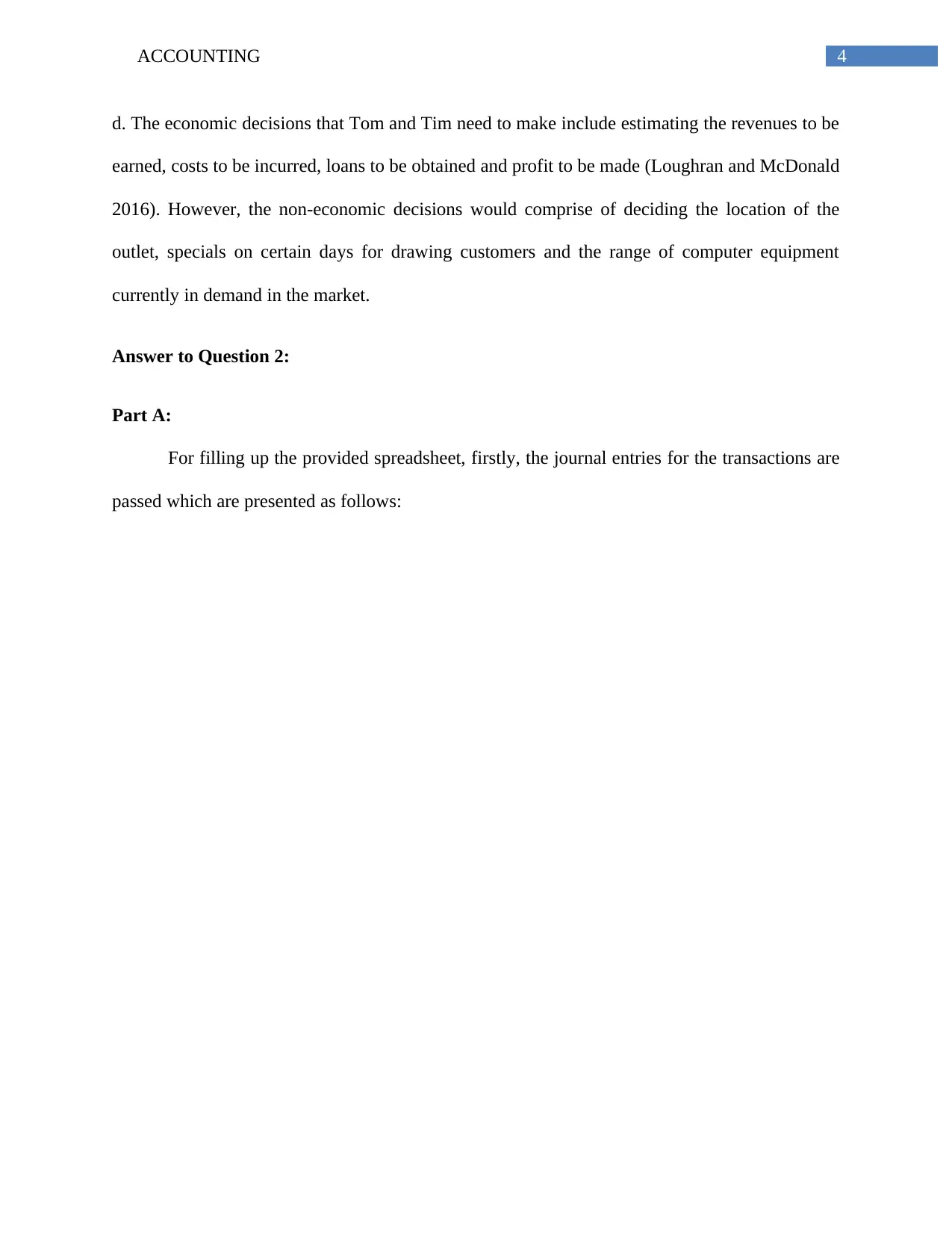
4ACCOUNTING
d. The economic decisions that Tom and Tim need to make include estimating the revenues to be
earned, costs to be incurred, loans to be obtained and profit to be made (Loughran and McDonald
2016). However, the non-economic decisions would comprise of deciding the location of the
outlet, specials on certain days for drawing customers and the range of computer equipment
currently in demand in the market.
Answer to Question 2:
Part A:
For filling up the provided spreadsheet, firstly, the journal entries for the transactions are
passed which are presented as follows:
d. The economic decisions that Tom and Tim need to make include estimating the revenues to be
earned, costs to be incurred, loans to be obtained and profit to be made (Loughran and McDonald
2016). However, the non-economic decisions would comprise of deciding the location of the
outlet, specials on certain days for drawing customers and the range of computer equipment
currently in demand in the market.
Answer to Question 2:
Part A:
For filling up the provided spreadsheet, firstly, the journal entries for the transactions are
passed which are presented as follows:
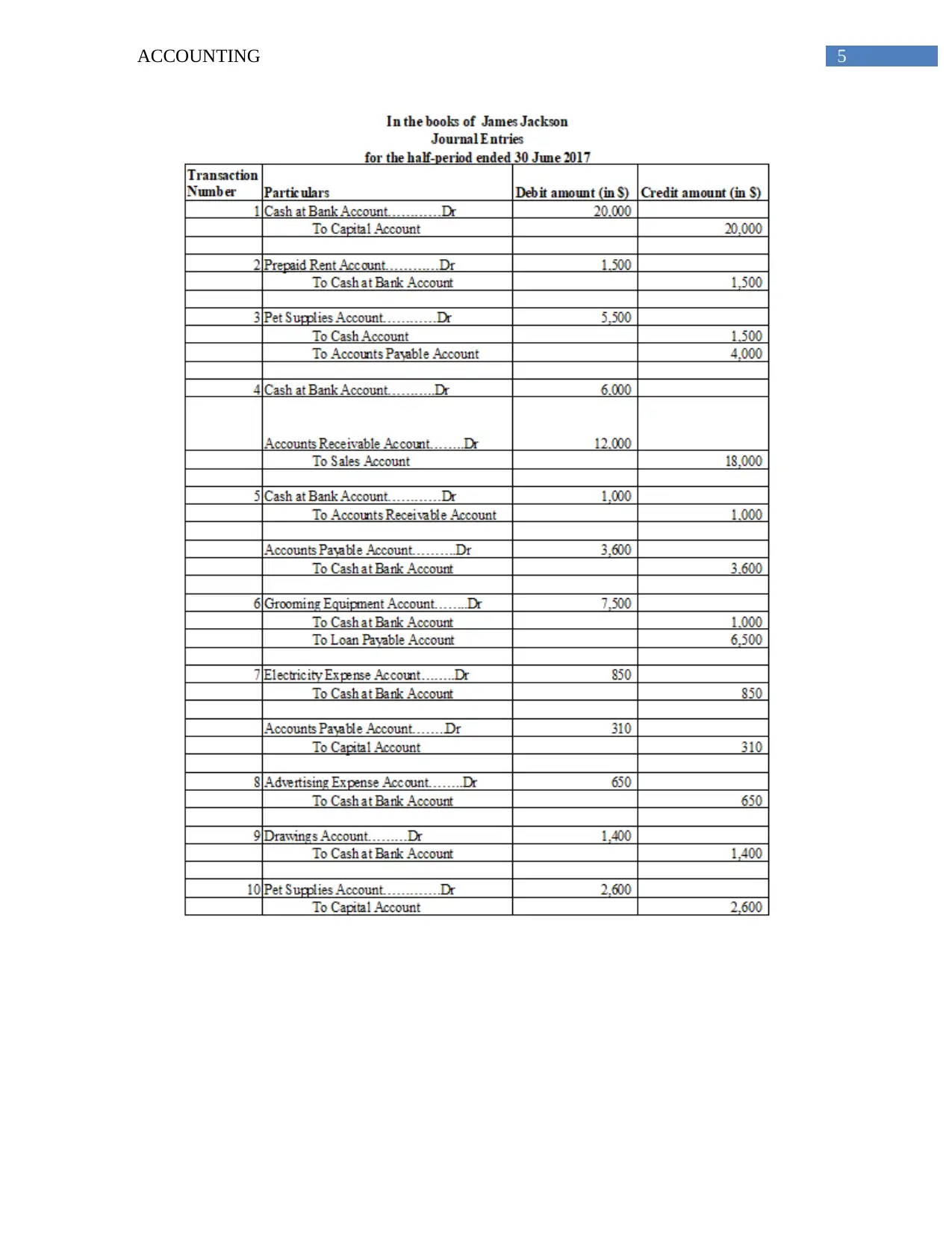
5ACCOUNTING
⊘ This is a preview!⊘
Do you want full access?
Subscribe today to unlock all pages.

Trusted by 1+ million students worldwide
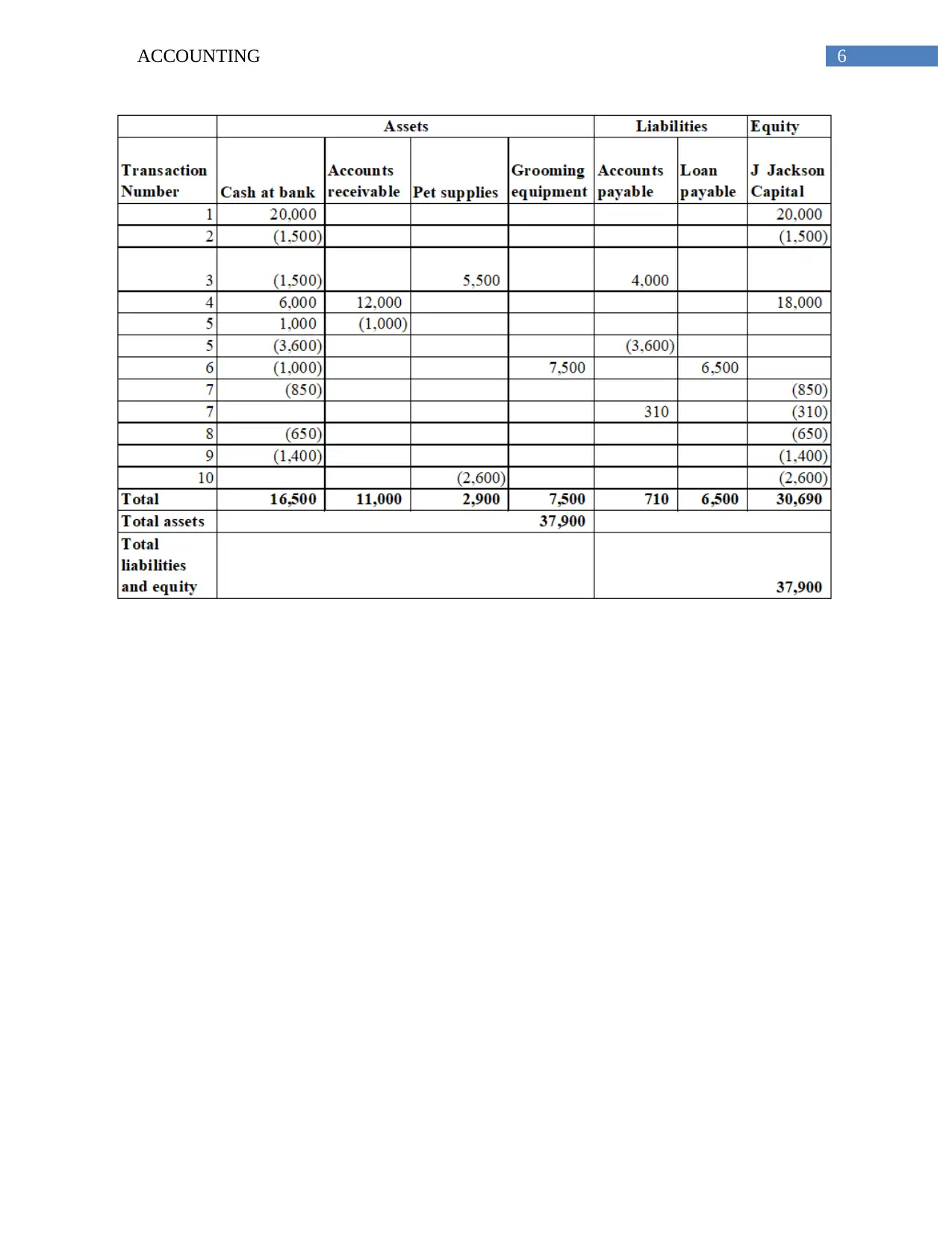
6ACCOUNTING
Paraphrase This Document
Need a fresh take? Get an instant paraphrase of this document with our AI Paraphraser
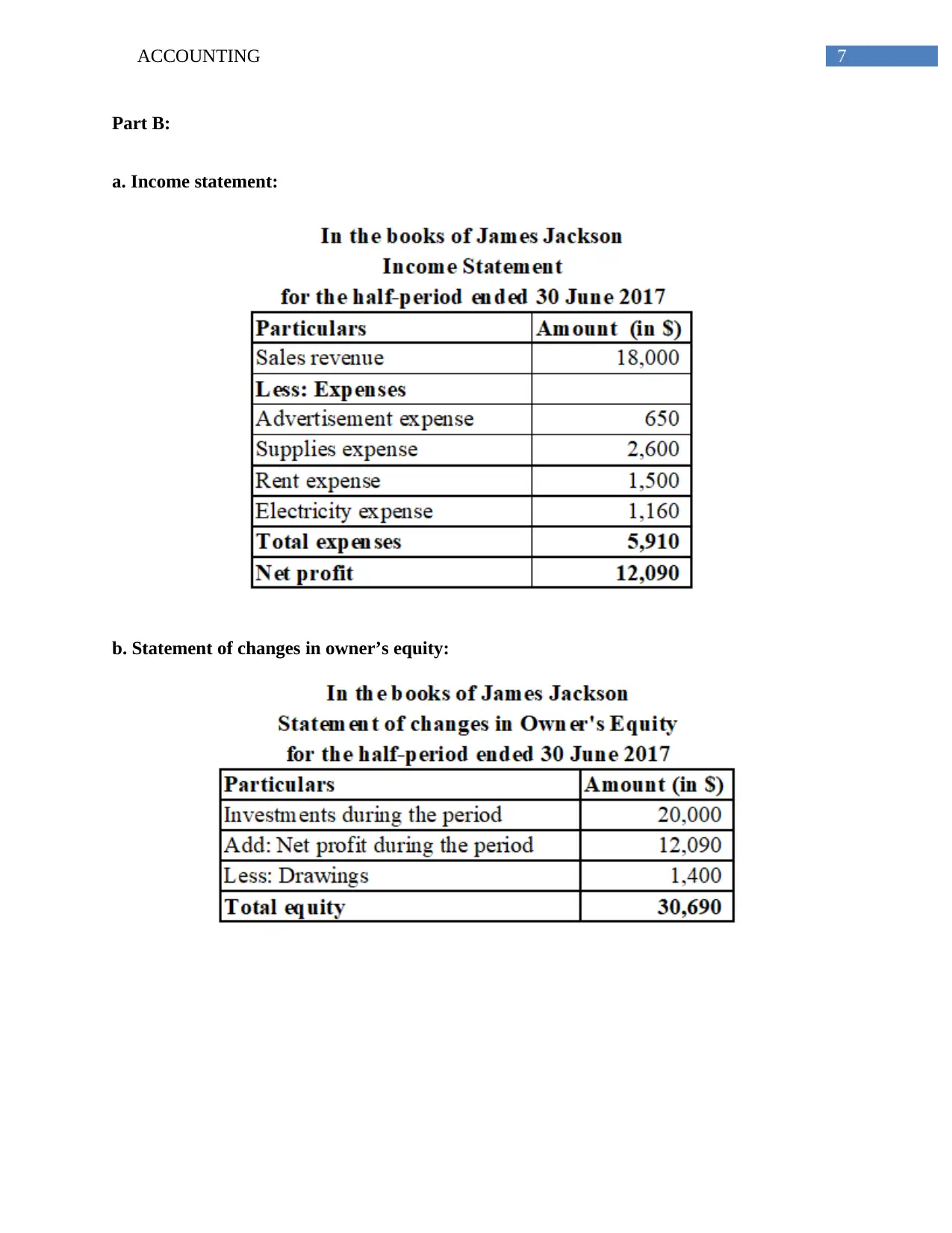
7ACCOUNTING
Part B:
a. Income statement:
b. Statement of changes in owner’s equity:
Part B:
a. Income statement:
b. Statement of changes in owner’s equity:
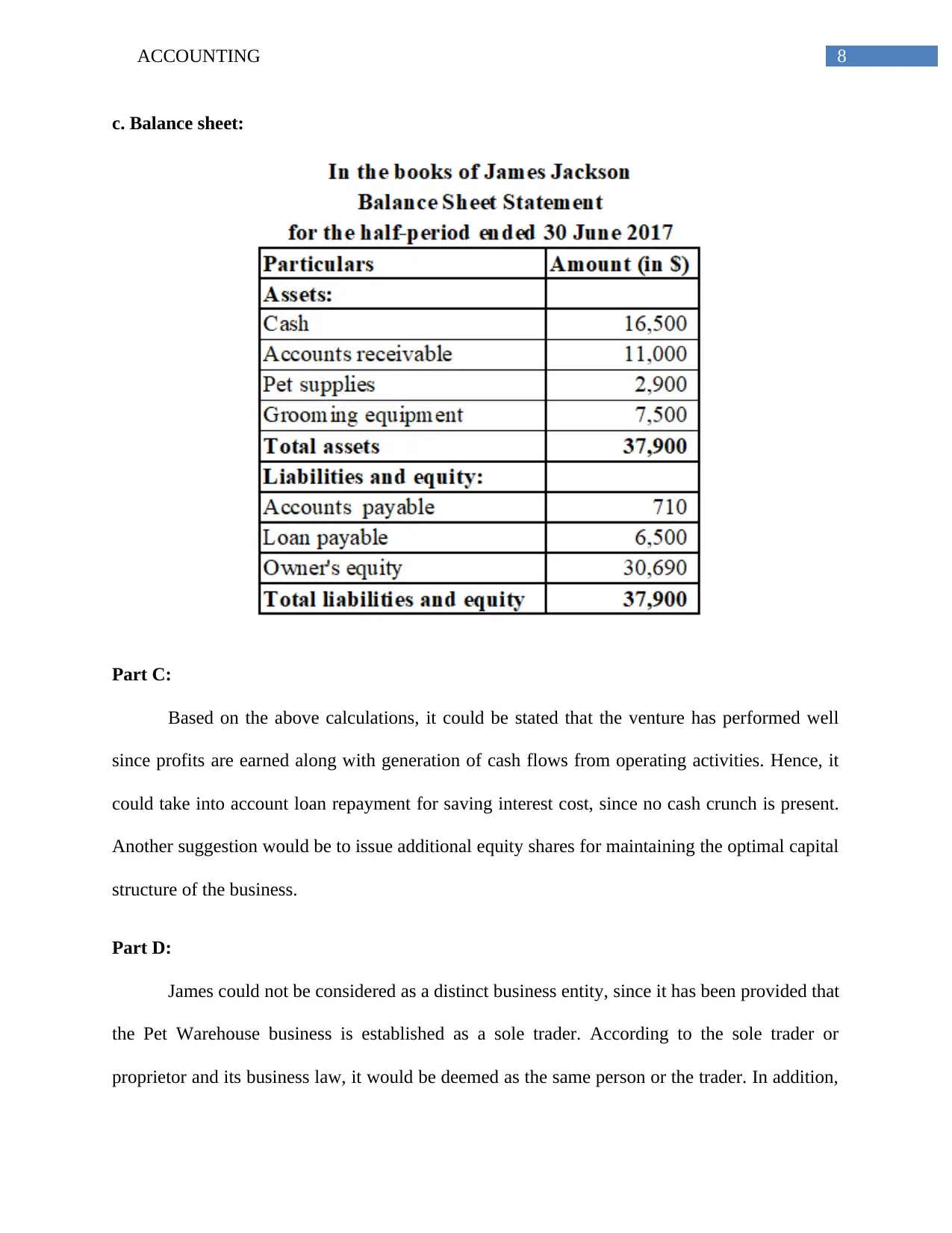
8ACCOUNTING
c. Balance sheet:
Part C:
Based on the above calculations, it could be stated that the venture has performed well
since profits are earned along with generation of cash flows from operating activities. Hence, it
could take into account loan repayment for saving interest cost, since no cash crunch is present.
Another suggestion would be to issue additional equity shares for maintaining the optimal capital
structure of the business.
Part D:
James could not be considered as a distinct business entity, since it has been provided that
the Pet Warehouse business is established as a sole trader. According to the sole trader or
proprietor and its business law, it would be deemed as the same person or the trader. In addition,
c. Balance sheet:
Part C:
Based on the above calculations, it could be stated that the venture has performed well
since profits are earned along with generation of cash flows from operating activities. Hence, it
could take into account loan repayment for saving interest cost, since no cash crunch is present.
Another suggestion would be to issue additional equity shares for maintaining the optimal capital
structure of the business.
Part D:
James could not be considered as a distinct business entity, since it has been provided that
the Pet Warehouse business is established as a sole trader. According to the sole trader or
proprietor and its business law, it would be deemed as the same person or the trader. In addition,
⊘ This is a preview!⊘
Do you want full access?
Subscribe today to unlock all pages.

Trusted by 1+ million students worldwide
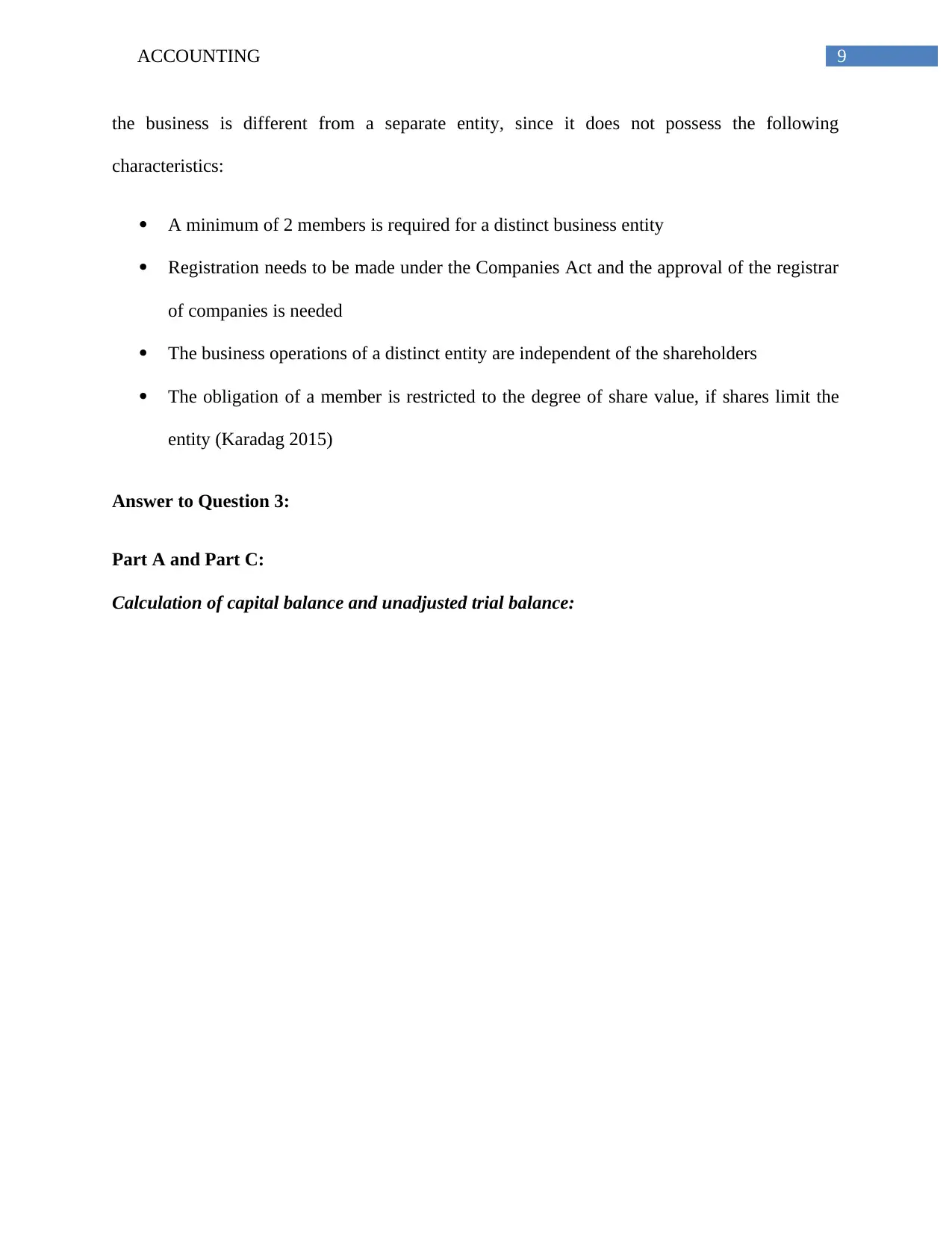
9ACCOUNTING
the business is different from a separate entity, since it does not possess the following
characteristics:
A minimum of 2 members is required for a distinct business entity
Registration needs to be made under the Companies Act and the approval of the registrar
of companies is needed
The business operations of a distinct entity are independent of the shareholders
The obligation of a member is restricted to the degree of share value, if shares limit the
entity (Karadag 2015)
Answer to Question 3:
Part A and Part C:
Calculation of capital balance and unadjusted trial balance:
the business is different from a separate entity, since it does not possess the following
characteristics:
A minimum of 2 members is required for a distinct business entity
Registration needs to be made under the Companies Act and the approval of the registrar
of companies is needed
The business operations of a distinct entity are independent of the shareholders
The obligation of a member is restricted to the degree of share value, if shares limit the
entity (Karadag 2015)
Answer to Question 3:
Part A and Part C:
Calculation of capital balance and unadjusted trial balance:
Paraphrase This Document
Need a fresh take? Get an instant paraphrase of this document with our AI Paraphraser
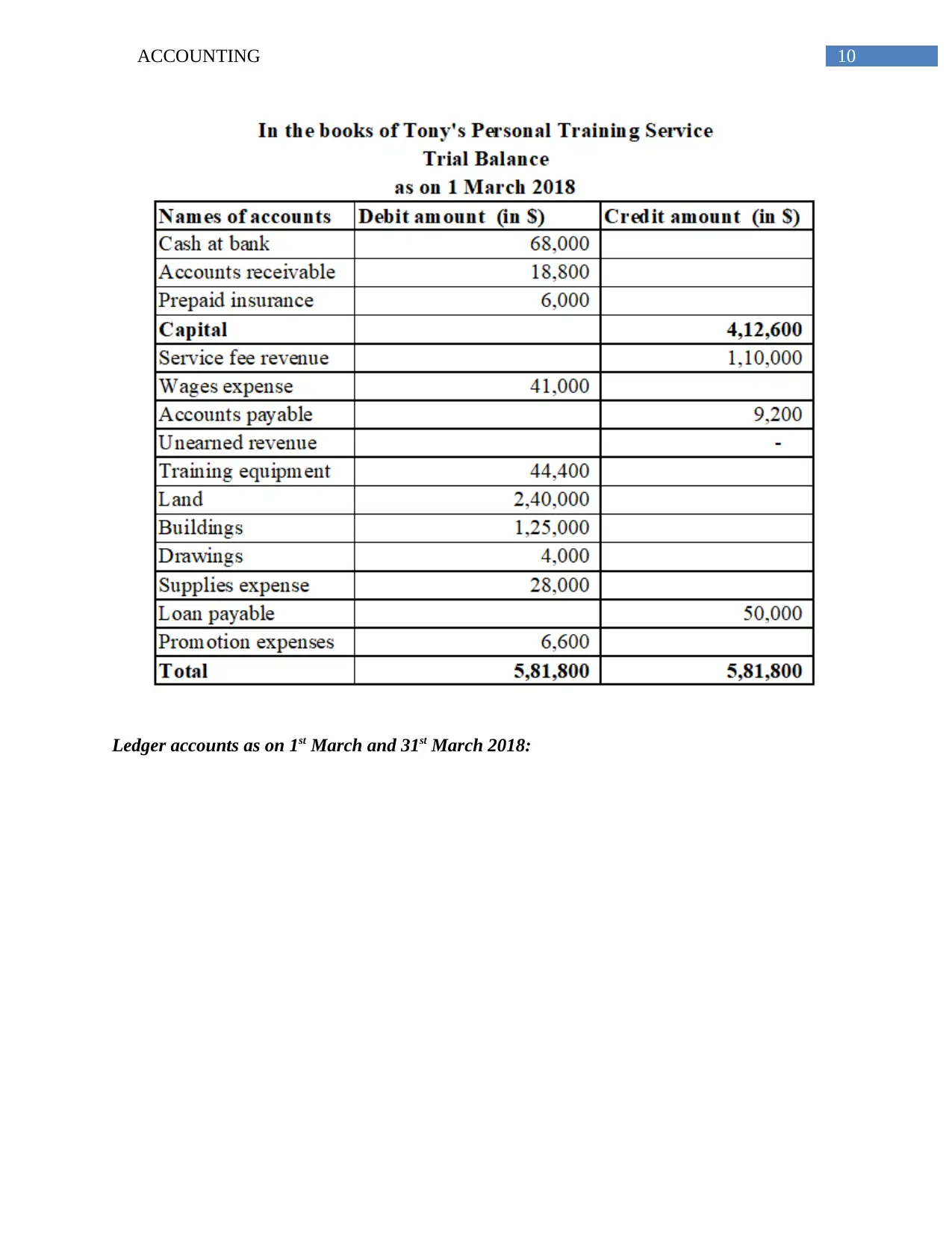
10ACCOUNTING
Ledger accounts as on 1st March and 31st March 2018:
Ledger accounts as on 1st March and 31st March 2018:
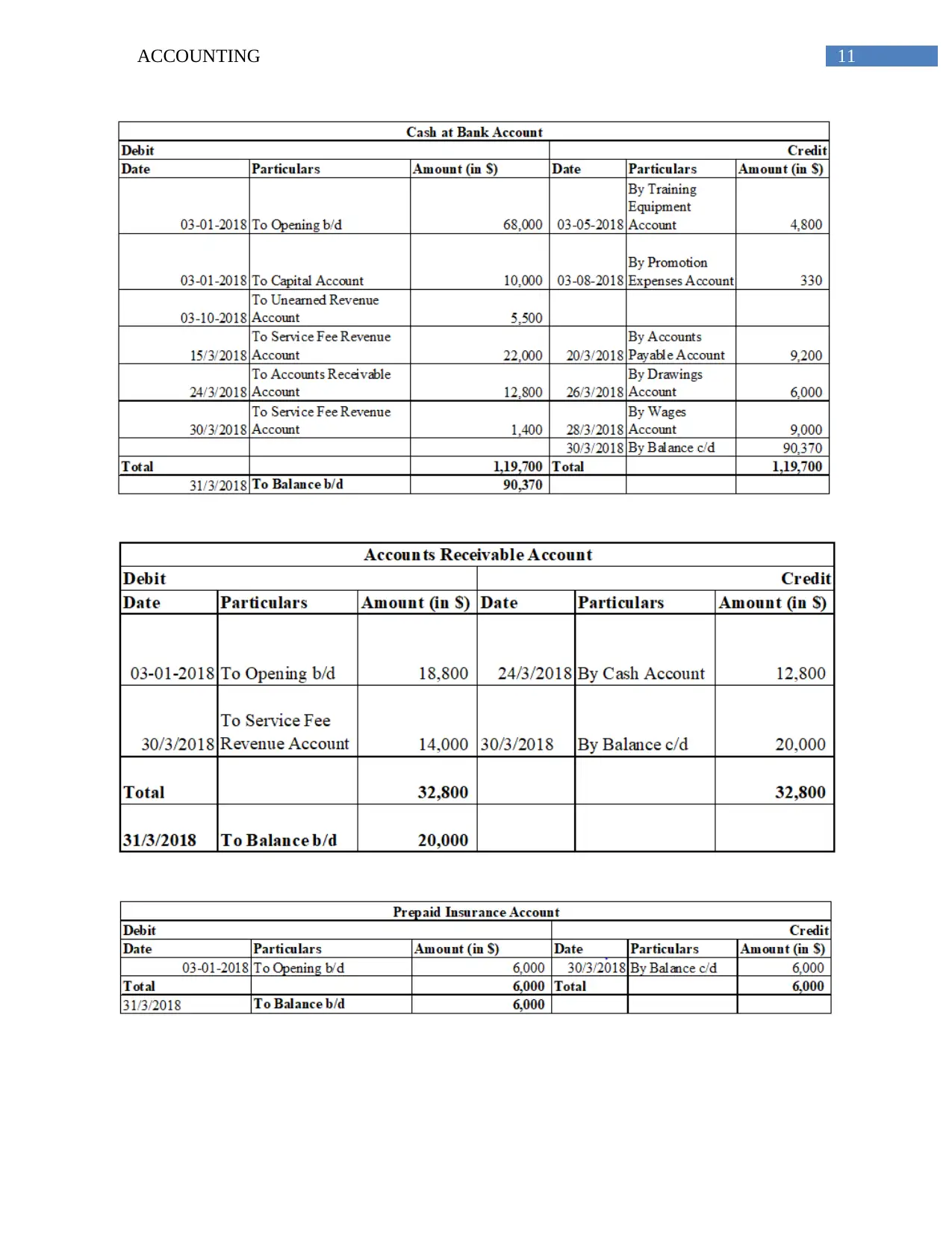
11ACCOUNTING
⊘ This is a preview!⊘
Do you want full access?
Subscribe today to unlock all pages.

Trusted by 1+ million students worldwide
1 out of 20
Related Documents
Your All-in-One AI-Powered Toolkit for Academic Success.
+13062052269
info@desklib.com
Available 24*7 on WhatsApp / Email
![[object Object]](/_next/static/media/star-bottom.7253800d.svg)
Unlock your academic potential
Copyright © 2020–2025 A2Z Services. All Rights Reserved. Developed and managed by ZUCOL.





